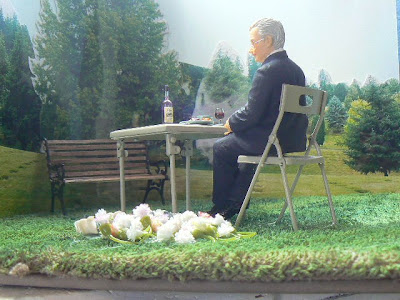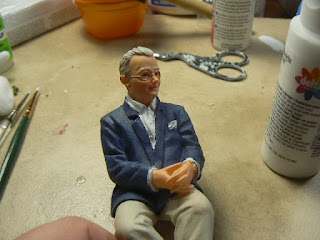This
scene was inspired by something I saw one day while driving. So first
let's travel back to that day and I will tell you about what I saw.
I
had been out shopping for the day and was heading home in the early
afternoon. It had been a busy day and I thinking about what I needed
to do yet when I got home. My normal route to and from shopping takes
me past a certain cemetery that is not only on a corner but at the
top of a hill. As I was coming up the road toward it I saw that some
thing was happening toward the center of the cemetery At first I
assumed it must be a funeral but as I got closer I found something
very different.
The
first thing I really noticed was a folding card table and one of
those metal folding chairs. (you know the kind, we have all sat on/at
them many times in our lives) and seated on the chair was an elderly
man. This man was wearing a suit and in front of him on the table was
a bottle of red wine, a filled wine glass and a plate. When I looked
to his side on the ground I found that he had spread a multitude of
cut flowers on what I assume was the resting place of someone he
loved very much.
I
realized that what I was seeing was this man having dinner with
someone very special.
I
could think of little else on the way home. As soon as I got the
items I had purchased put away I told some friends online. We
discussed this for the rest of the weekend. It was just so touching.
It made us all want to know more.
I
found that for the next several days the scene stayed with me. It was
in my thoughts often. I felt the need to do something with the scene.
I really wished that I had the talent to paint because I think this
would have been a wonderful subject of a painting. But, I can not
paint so I did the next best thing. I started thinking of ways to
make a miniature scene of what I had witnessed.
I
immediately knew the kind of box it could go in. I made a very
similar box to use to photograph miniatures a few years ago. It is
simply constructed from 3 squares of foam-core. Glued together to
make a portion of a cube. I knew the base square could be covered by
grass and I could add a headstone.
The
next task was to find a suitable figure to represent the man I had
seen. I looked at several options and settled on one of the resin
figures from miniatures.com the one they call Charles. Charles is
simply an elderly gentleman that is seated with his hands folded in
his lap. He is dressed in a sport coat and slacks where the man at
the cemetery was in a suit. So after a lot of debating with myself
and asking the advice of some friends I began the process of
re-painting him. I covered that process in a recent blog entry (you can see it here)
The
table and chair were also found on the same site. I was concerned as
to whether Charles could sit comfortably on the chair and look to in
correct proportion. I posted on the sites Facebook page with my
question and was thrilled to have the fit checked for me by someone
there. That was excellent service and made the decision to purchase
much easier. I also ordered the bottle and glass of wine that I would
need to for the scene.
As
soon as my order arrived I was able to make a final decision on the
size my project would be. I wanted to make sure I had just the right
amount of space around my setting.
Next
I needed to get some photos taken to use as the backdrop so that the
scene was set in a place.
I
was able to convince an very good friend to go with me to take the
pictures I used for the backdrop of the scene. It seemed weird to go
alone to a cemetery to take random pictures. Also I had no idea where
would be the best place to go and my friend was able to suggest the
perfect location.
Now
to get the pictures printed and then move onto the next step, making
the pictures and the background into a cohesive backdrop.
After printing the photographs as 8” x 10” enlargements I then did my best to match the color of the sky that day. I found that by using some spray paint in a gloss white over my bright blue tag board background I was able to get a very close match the cloudy Oregon sky on the day we shot the photographs.
Then
I chose which parts of the pictures I wanted to use. I proceeded to
cut around the distant trees and cut the pictures so they best
blended together to form a background that stretched to cover the
back of the display piece.
Now
onto the grass. I decided to use my standard method for making grass,
a light brown terry towel. I first saw this process many, many years
ago in some mini magazine or another. I think the article used a
green towel but I prefer to use a brown one. I can never find a green
towel that is anywhere near the color of grass. I find the brown
being under the green top fools the eye into thinking that it is just
dirt. My process is to take various colors of green craft paint and a
stiff paint brush to paint the grass. If you do this the biggest
trick to not have too much paint on your brush. It is almost a dry
brushing technique. Work in many layers until you get the effect you
want. Remember you can always add more paint, you really can't take
any off once it is in place.
My
grass/ towel was glued to a foamcore piece that fit the bottom of my
box before painting. I had also cut out two holes to place the
headstones that were to go in the foreground under. After all the
paint was dry I simply used some box tape to tape some of those
little samples of laminate counter-top material. I had gotten the
samples years ago for a project that never happened and I decided the
fake stone laminate would make very nice headstones. I decided to
not personalize the headstones at all for this scene. That seemed
like it would have just not been the correct thing to do.
So
now I had the background all set, the grass ready to go in, Charles
was all painted and his table was set and ready for dinner. The next
logical step was to glue a sheet of paper to the outside. I am not
exactly sure what the paper is called. I buy it in large sheets (19”x
25”) at the craft store near the watercolor paper. It is the same
paper I use to wallpaper my dollhouses when I want the look of a
painted wall. I wrapped the paper around the edges of the box so the
raw foamcore would be finished off. I used the same YES paste that I
use when ever I wallpaper in miniature.
With
the outside finished off it was time to glue in the background and
the grass and then add Charles and his table and chair.
Now
with the scene coming together I needed to disguise the joint between
the pictures. I had ordered parts to make a park bench a few months
ago and found the bench to be the perfect addition to the scene.
For
the flowers I used some tiny flowers from the craft store, some I
tinted with markers, I used my hot glue gun to adhere the flowers to
replicate what I had seen that day.




















































